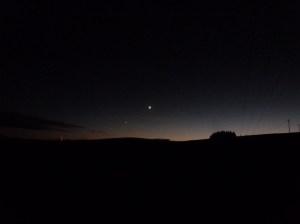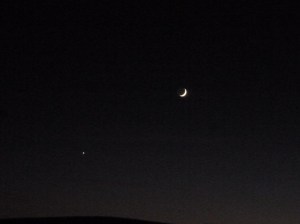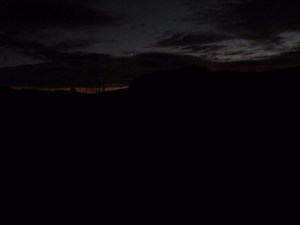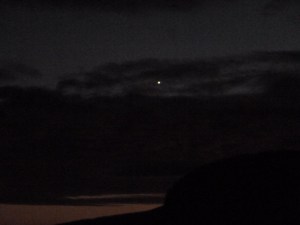The target “Comet Panstarr” is the astronomical highlight for me this month, and as such the task, should you wish to accept, is to view find it in the night skies. Here follows the adventures or misadventures of the Lost Naturalist and her companion to achieve this aim.
Sunday – Doesn’t begin well, snow showers on and off all day!! However, my loyal assistant dresses up like “Nanook of the North” and goes on a scouting mission hunting for the Moon and so the Comet Panstarr in the gaps between the quickly moving clouds and various snow showers!! No sign – just snow!
Monday – More snow on and off during the day – in fact in the morning, we’d got up to three or four inches of the stuff, accompanied though by some wonderful bright blue skies, unfortunately by the time night fell, the sky was socked in with clouds – No chance!!
Tuesday – A day when the temperatures rose as the cloud settled in and the snow melted rapidly, unfortunately it meant that all chance of seeing anything was lost in the cloud. Again!!
Wednesday – At last an evening, of biting coldness, but that meant the sky was crystal clear and stars shone brightly!! At last a decent opportunity to go Comet Panstarr hunting!!
Going out just after sunset, when the western sky still retained the last stains of the warm orange glow of the setting sun. As we waited for darkness to fall, there was the sudden whoosh overhead of a small flock of rushing birds, as they headed rapidly to their roosts for the night, and the icy stillness of the evening was disturbed by the final squabbles of the local Coots, settling down on a near by lake. Unfortunately this wonderful stillness was then shattered, as the quiet lane suddenly became the M6, as a number of cars passed by. Each of which slowed down to observe the activities of two lost or maybe mad Naturalists looking for a Comet!!
Even though the darkness of night had yet to fully fall, the tiny sliver of the crescent Moon shone exceptionally brightly, as though it was being lit by a spotlight. It was so well lit that the Earth shine shadow was really obvious to the naked eye, almost as though the rest of the moon was just out of focus. Through the scope, the Moon also revealed the Seas on the Moon as darker shadows with the darker Earth shine area. The scope also revealed the details of the craters on the thin crescent in full light, they were so bright and fresh that they felt exceptionally close, as though you could almost reach out and touch them, if you just had the courage. Its that same urge, that comes when you see that glossy new coat of wet paint and just have to put your finger on it!!

The Crescent Moon with Earth Shine – 13 March 2013 (Copyright Ross Lockley)
As the sky darkened the the surrounding stars also began to come into view, with Jupiter shining out as a bright beacon first. Followed more slowly by the various stars of Orion, beginning with the shoulders and working down the body as the sky progressively darkened, until just before we left, after the Moon had set, the whole constellation was visible.
On the Comet Panstarrs front, not so much luck. Doesn’t really help that we were not looking in quite the right area of space! We were looking above the Moon, unfortunately by Wednesday the Comet would have been below the Moon – Oops!! Also it doesn’t help here; that the surrounding hills mean that the Moon set before it was really dark in the west.
Thursday – Yesterday was another evening where the skies were covered by cloud!!!
Friday – Had thought that this evening was going to be another write off, as just before the sun set it had been raining again, and to the front of the house the sky was still covered in thick dark clouds, however, outback the clouds had broken and the Moon shone out – signalling another attempt.
As time was moving on and the Comet Panstarr would by now be low in the sky and soon setting behind the surrounding hills, we dashed down the road, to another view point, lower hills here and this time armed with a decent set of instructions. There was the crescent Moon and about a hand span below and to the right, there in full view in the scope’s eye piece (unfortunately not visible to the naked eye) and almost setting on the horizon, was the Comet Panstarr!!! A glorious fuzzy mass, but somehow amazing and very wondrous!! Not at all like the classic view of a Comet, with a tail streaking out behind, just a fuzzy mass, but still something that once gone from view in a few weeks time, won’t return again in my life time, so amazing and wondrous!!
 The Moon – Below which but not visible would be Comet Panstarr – 15 March 2013 (Copyright Ross Lockley)
The Moon – Below which but not visible would be Comet Panstarr – 15 March 2013 (Copyright Ross Lockley)
 The Dying Rays of the Sun – 05 December 2013 (Copyright Carol Jones)
The Dying Rays of the Sun – 05 December 2013 (Copyright Carol Jones) The Moon and Venus – 05 December 2013 (Copyright Carol Jones)
The Moon and Venus – 05 December 2013 (Copyright Carol Jones)






